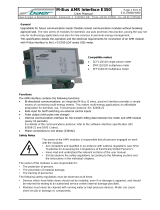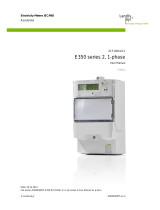Page is loading ...

E350/40 and E350/41 WET HEAT BAINS MARIE
E350/42 and E350/43 DRY HEAT BAINS MARIE
INSTALLATION and SERVICING INSTRUCTIONS
IMPORTANT
The installer must ensure that the installation of the appliance is in conformity with these instructions and
National Regulations in force at the time of installation. Particular attention MUST be paid to –
BS7671 IEE Wiring Regulations
Electricity at Work Regulations
Health And Safety At Work Act
Fire Precautions Act
This appliance has been CE-marked on the basis of compliance with the Low Voltage and EMC Directives
for the voltages stated on the Data Plate
WARNING -THIS APPLIANCE MUST BE EARTHED
On completion of the installation these instructions should be left with the Engineer-in-Charge for reference
during servicing. Further to this, The Users Instructions should be handed over to the User, having had a
demonstration of the operation and cleaning of the appliance.
IT IS MOST IMPORTANT THAT THESE INSTRUCTIONS BE CONSULTED BEFORE INSTALLING AND
COMMISSIONING THIS APPLIANCE. FAILURE TO COMPLY WITH THE SPECIFIED PROCEDURES
MAY RESULT IN DAMAGE OR THE NEED FOR A SERVICE CALL.
PREVENTATIVE MAINTENANCE CONTRACT
In order to obtain maximum performance from this unit we would recommend that a Maintenance Contract
be arranged with SERVICELINE. Visits may then be made at agreed intervals to carry out adjustments and
repairs. A quotation will be given upon request to the contact numbers below.
WEEE Directive Registration No. WEE/DC0059TT/PRO
At end of unit life, dispose of appliance and any replacement parts in a safe manner, via a
licensed waste handler.
Units are designed to be dismantled easily and recycling of all material is encouraged
whenever practicable.
Falcon Foodservice Equipment
HEAD OFFICE AND WORKS
Wallace View, Hillfoots Road, Stirling. FK9 5PY. Scotland.
SERVICELINE CONTACT
Phone: 01438 363 000
T100666 Ref.4

Electrical Safety and Advice Regarding Supplementary Electrical Protection
Commercial kitchens and foodservice areas are environments where electrical appliances may be located
close to liquids, or operate in and around damp conditions, or where restricted movement for installation
and service is evident.
The installation and periodic inspection of the appliance should only be undertaken by a qualified, skilled
and competent electrician; and connected to the correct power supply suitable for load as stipulated by the
appliance data label.
The electrical installation and connections should meet the necessary requirements to local electrical
wiring regulations and electrical safety guidelines.
We recommend:-
Supplementary electrical protection with use of a residual current device (RCD).
Fixed wiring appliances incorporate a locally situated switch disconnector to connect to, which is
easily accessible for switching off and safe isolation purposes. The switch disconnector must meet
the specification requirements of IEC 60947.

Warranty Policy Shortlist
Warranty does not cover :-
Correcting faults caused by incorrect installation of a product.
Where an engineer cannot gain access to a site or a product.
Repeat commission visits.
Replacement of any parts where damage has been caused by misuse.
Engineer waiting time will be chargeable.
Routine maintenance and cleaning.
Gas conversions i.e. Natural to Propane gas.
Descaling of water products and cleaning of water sensors where softeners/conditioners are not
fitted, or are fitted and not maintained.
Blocked drains.
Independent steam generation systems.
Gas, water and electrical supply external to unit.
Light bulbs.
Re-installing vacuum in kettle jackets.
Replacement of grill burner ceramics when damage has been clearly caused by misuse.
Where an engineer finds no fault with a product that has been reported faulty.
Re-setting or adjustment of thermostats when unit is operating to specification.
Cleaning and unblocking of fryer filter systems due to customer misuse.
Lubrication and adjustment of door catches.
Cleaning and Maintenance
Cleaning of burner jets
Poor combustion caused by lack of cleaning
Lubrication of moving parts
Lubrication of gas cocks
Cleaning/adjustment of pilots
Correction of gas pressure to appliance.
Renewing of electric cable ends.
Replacement of fuses
Corrosion caused by use of chemical cleaners.
SECTION 1 – INSTALLATION

UNLESS OTHERWISE STATED, PARTS WHICH HAVE BEEN PROTECTED BY THE
MANUFACTURER ARE NOT TO BE ADJUSTED BY THE INSTALLER
1.1 MODEL NUMBER, NETT WEIGHTS and DIMENSIONS
MODEL
WIDTH
mm
DEPTH
mm
HEIGHT
mm
WEIGHT
kgs
WEIGHT
lbs
E350/40
350
650
305
20
44
E350/41
700
650
305
33
73
E350/42
350
650
305
18
39
E350/43
700
650
305
30
67
All Weights are nett, exclusive of containers.
1.2 SITING
The unit should be installed on a table or similar surface. Alternatively it may be installed
upon the purpose designed floor-stand, supplied by Falcon. If it is to be positioned in close
proximity to a wall, partition etc., a clearance of 25mm at the rear and sides should be
observed. A vertical clearance of 600mm between the top of the appliance and any overlying
combustible surface must also be provided.
1.3 ELECTRICAL SUPPLY
These appliance are for use on single phase AC supplies only.
1.4 SUPPLY CONNECTION
The cable entry is located at rear of appliance and is suitable for 20mm conduit.
A suitable isolating switch with 3mm separation on both poles must be installed.
All wiring must be executed in accordance with regulations listed on cover of this manual.
This appliance must be earthed. A suitable terminal is provided for this purpose and this must be
used.
This appliance is also provided with a terminal for the connection of an external equipotential
conductor. This terminal is in effective electrical contact with all fixed exposed metal parts of the
appliance, and shall allow the connection of a conductor having a nominal cross-sectional area of up
to 10 mm². It is located on the rear panel and is identified by the following label and must only be
used for bonding purposes.
1.5 ELECTRICAL RATINGS
Electrical ratings are as stated on appliance data plate.
1.6 CONTROLS
All models are controlled by a single thermostat.
SECTION 2 – ASSEMBLY
2.1 E350/40 and E350/41 Wet Bains Marie

a) Remove feet from bag and screw into locations on unit base prior to positioning.
b) Place unit in position and carefully level it, using feet adjusters if it is to be mounted on a
counter or table. If it is to be installed a stand, please refer to instructions supplied with
accessory.
c) The appliance is supplied complete and ready to be connected to supply mains.
d) To gain access to terminals, the front facia panel has to be removed. Remove two fixings
in upper flange of panel, below overhanging hob. Ease top of panel forward then lift it
upward to release lower fixings.
e) Terminal block is now accessible and supply cables can be fed to it through inbuilt conduit
tube.
f) After connecting unit, replace facia panel and ensure that bottom location is properly
assembled.
g) Do not install water well at this stage and switch on unit to check that elements,
thermostat and pilot lamps are functioning correctly. The RED neon is lit when power is
available i.e. isolating switch is closed. The AMBER neon is lit when elements are ON, it will
go out whenever thermostat opens.
h) After satisfactory completion of installation, demonstrate the method of operation to
kitchen staff and point out location of isolating switch for use in an emergency or during
routine cleaning etc.
2.2 E350/42 and E350/43 Dry Bains Marie
a) Position unit and carefully level it using feet adjusters on a counter or table. If it is to be
installed upon a stand, please refer to instructions supplied with stand.
b) The appliance is supplied complete and ready to connect to mains supply.
c) To gain access to terminals, proceed as follows:
Lift out container supports at top of unit and also perforated spreader plate which covers
element.
Remove drip shield which covers terminal box at rear of appliance.
Remove terminal box cover.
d) Terminal block is now accessible and supply cables can be connected.
e) After connections have been made, replace all components, noting that large holes in
spreader plate must face toward rear.
f) Switch unit ON. Check that elements are heating and that pilot lamps are functioning. The
RED neon is lit when power is available, i.e. isolating switch is closed. The AMBER neon is
lit when elements are ON, and will go out whenever thermostat opens.
g) After satisfactory completion of installation, demonstrate method of operation to kitchen
staff. Point out location of isolating switch for use in an emergency or during routine
cleaning.
SECTION 3 – SERVICING
BEFORE ATTEMPTING ANY MAINTENANCE, SWITCH OFF AT THE MAINS ISOLATING
SWITCH AND TAKE STEPS TO ENSURE THAT IT IS NOT INADVERTENTLY
SWITCHED ON.
When ordering spares, please quote model number, serial number and voltage as stamped
on data plate at rear of appliance.
3.1 CONTROL PANEL - To Remove
3.1.1 Wet Heat Models
a) Remove two screws in upper flange of panel. i.e. below front hob overhang.
b) Ease panel forward at top, then lift it slightly to release lower locations.
c) Move panel forward.
3.1.2 Dry Heat Models
a) Remove drip tray located below control panel.
b) Remove two screws in upper flange of control panel.
c) Allow panel to drop down slightly to release lower fixings and remove panel.

3.2 THERMOSTAT - To Remove
3.2.1 Wet Heat Models
a) Remove control panel. (See Section 3.1.1)
b) Remove well complete with containers etc. by grasping handles and lifting vertically.
c) Remove thermostat phial from fixing clips.
d) Pull off thermostat connections, noting locations.
e) Pull off knob and remove two screws.
f) From inside controls compartment, undo gland nut which secures thermostat tube to boss.
Push phial down into compartment and remove thermostat.
g) Upon re-fitting, ensure insulating sleeving covers capillary tube. Neatly coil excess length
over a suitable object of approximately 50mm diameter.
Ensure that earth-bonding terminal is re-fitted underneath thermostat fixing lug.
3.2.2 Dry Heat Models
a) Remove control panel. (See Section 3.1.2)
b) Remove any containers etc.
c) Remove thermostat phial from fixing clips.
d) Pull off thermostat connections, noting locations.
e) Pull off thermostat knob and remove two fixing screws.
f) From inside controls compartment, undo gland nut which secures capillary tube to boss.
Push phial downward into compartment and remove thermostat.
g) When refitting, ensure that insulating sleeving is fitted to capillary tube. Neatly coil excess
length over a suitable round object of approximately 50mm diameter.
Ensure that earth-bonding terminal is re-fitted below thermostat fixing lug.
3.3 PILOT LAMPS - To Remove
All Models
a) Remove control panel. (See Section 3.1)
b) Pull off lamp connections.
c) Undo nut that secures lamp at rear to remove. Fit replacement in reverse order.
3.4 HEATING ELEMENTS - To Remove
3.4.1 Wet Heat Models
a) Remove control panel (See Section 3.1.1)
b) Remove water well etc. (See Section 3.2.1)
c) From inside of controls compartment, remove element connections.
d) Remove fixings that secure element and remove it.
e) When replacing element, ensure that earth bonding wires are reconnected to element
flanges using shakeproof washers below nuts.
3.4.2 Dry Heat Models
a) Remove control panel. (See Section 3.1.2)
b) Remove all containers, supporting components and perforated spreader panel which
covers element.
c) Remove element connections from inside controls compartment.
d) Undo fixings that secure element and remove it.
Replace all parts in reverse order. Take care to refit serrated washers below element fixing
nuts.
Reposition spreader plate with large holes facing toward rear.

E350/40/42 WIRING DIAGRAM

E350/41/43 WIRING DIAGRAM
/


